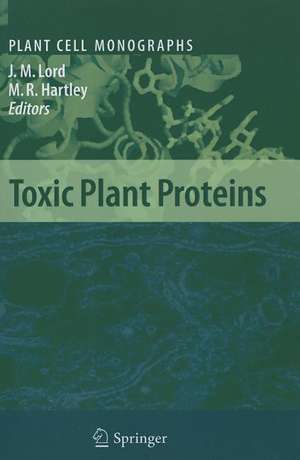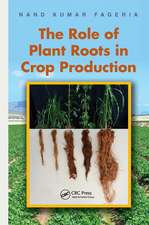Toxic Plant Proteins: Plant Cell Monographs, cartea 18
Editat de J. Michael Lord, Martin R. Hartleyen Limba Engleză Paperback – 5 sep 2012
| Toate formatele și edițiile | Preț | Express |
|---|---|---|
| Paperback (1) | 942.63 lei 6-8 săpt. | |
| Springer Berlin, Heidelberg – 5 sep 2012 | 942.63 lei 6-8 săpt. | |
| Hardback (1) | 948.16 lei 6-8 săpt. | |
| Springer Berlin, Heidelberg – 17 iun 2010 | 948.16 lei 6-8 săpt. |
Din seria Plant Cell Monographs
- 18%
 Preț: 947.04 lei
Preț: 947.04 lei - 24%
 Preț: 797.39 lei
Preț: 797.39 lei - 18%
 Preț: 957.62 lei
Preț: 957.62 lei - 18%
 Preț: 943.88 lei
Preț: 943.88 lei - 24%
 Preț: 790.03 lei
Preț: 790.03 lei - 18%
 Preț: 952.89 lei
Preț: 952.89 lei - 18%
 Preț: 948.16 lei
Preț: 948.16 lei - 18%
 Preț: 950.84 lei
Preț: 950.84 lei - 18%
 Preț: 1381.43 lei
Preț: 1381.43 lei - 18%
 Preț: 1226.73 lei
Preț: 1226.73 lei - 18%
 Preț: 952.89 lei
Preț: 952.89 lei - 18%
 Preț: 943.43 lei
Preț: 943.43 lei - 18%
 Preț: 956.03 lei
Preț: 956.03 lei - 18%
 Preț: 1121.76 lei
Preț: 1121.76 lei - 18%
 Preț: 1386.48 lei
Preț: 1386.48 lei - 15%
 Preț: 634.00 lei
Preț: 634.00 lei - 24%
 Preț: 785.85 lei
Preț: 785.85 lei - 18%
 Preț: 953.20 lei
Preț: 953.20 lei - 18%
 Preț: 952.09 lei
Preț: 952.09 lei - 18%
 Preț: 950.66 lei
Preț: 950.66 lei - 18%
 Preț: 945.30 lei
Preț: 945.30 lei - 18%
 Preț: 948.79 lei
Preț: 948.79 lei - 18%
 Preț: 1231.47 lei
Preț: 1231.47 lei
Preț: 942.63 lei
Preț vechi: 1149.54 lei
-18% Nou
Puncte Express: 1414
Preț estimativ în valută:
180.40€ • 187.64$ • 148.93£
180.40€ • 187.64$ • 148.93£
Carte tipărită la comandă
Livrare economică 15-29 aprilie
Preluare comenzi: 021 569.72.76
Specificații
ISBN-13: 9783642263774
ISBN-10: 3642263771
Pagini: 280
Ilustrații: X, 270 p. 41 illus., 12 illus. in color.
Dimensiuni: 155 x 235 x 15 mm
Greutate: 0.36 kg
Ediția:2010
Editura: Springer Berlin, Heidelberg
Colecția Springer
Seria Plant Cell Monographs
Locul publicării:Berlin, Heidelberg, Germany
ISBN-10: 3642263771
Pagini: 280
Ilustrații: X, 270 p. 41 illus., 12 illus. in color.
Dimensiuni: 155 x 235 x 15 mm
Greutate: 0.36 kg
Ediția:2010
Editura: Springer Berlin, Heidelberg
Colecția Springer
Seria Plant Cell Monographs
Locul publicării:Berlin, Heidelberg, Germany
Public țintă
ResearchCuprins
Evolution of Plant Ribosome-Inactivating Proteins.- RNA N-Glycosidase Activity of Ribosome-Inactivating Proteins.- Enzymatic Activities of Ribosome-Inactivating Proteins.- Type I Ribosome-Inactivating Proteins from Saponaria officinalis.- Type 1 Ribosome-Inactivating Proteins from the Ombú Tree (Phytolacca dioica L.).- Sambucus Ribosome-Inactivating Proteins and Lectins.- Ribosome-Inactivating Proteins from Abrus pulchellus.- Ribosome-Inactivating Proteins in Cereals.- Ribosome Inactivating Proteins and Apoptosis.- The Synthesis of Ricinus communis Lectins.- How Ricin Reaches its Target in the Cytosol of Mammalian Cells.- Ribosome-Inactivating Protein-Containing Conjugates for Therapeutic Use.
Textul de pe ultima copertă
Many plants produce enzymes collectively known as ribosome-inactivating proteins (RIPs). RIPs catalyze the removal of an adenine residue from a conserved loop in the large ribosomal RNA. The adenine residue removed by this depurination is crucial for the binding of elongation factors. Ribosomes modified in this way are no longer able to carry out protein synthesis. Most RIPs exist as single polypeptides (Type 1 RIPs) which are largely non-toxic to mammalian cells because they are unable to enter them and thus cannot reach their ribosomal substrate. In some instances, however, the RIP forms part of a heterodimer where its partner polypeptide is a lectin (Type 2 RIPs). These heterodimeric RIPs are able to bind to and enter mammalian cells. Their ability to reach and modify ribosomes in target cells means these proteins are some of the most potently cytotoxic poisons found in nature, and are widely assumed to play a protective role as part of the host plant’s defenses. RIPs are able to further damage target cells by inducing apoptosis. In addition, certain plants produce lectins lacking an RIP component but which are also cytotoxic. This book focuses on the structure/function and some potential applications of these toxic plant proteins.
Caracteristici
Written by acknowledged experts in the field the book focuses on the structure, function and some potential applications of toxic plant proteins










